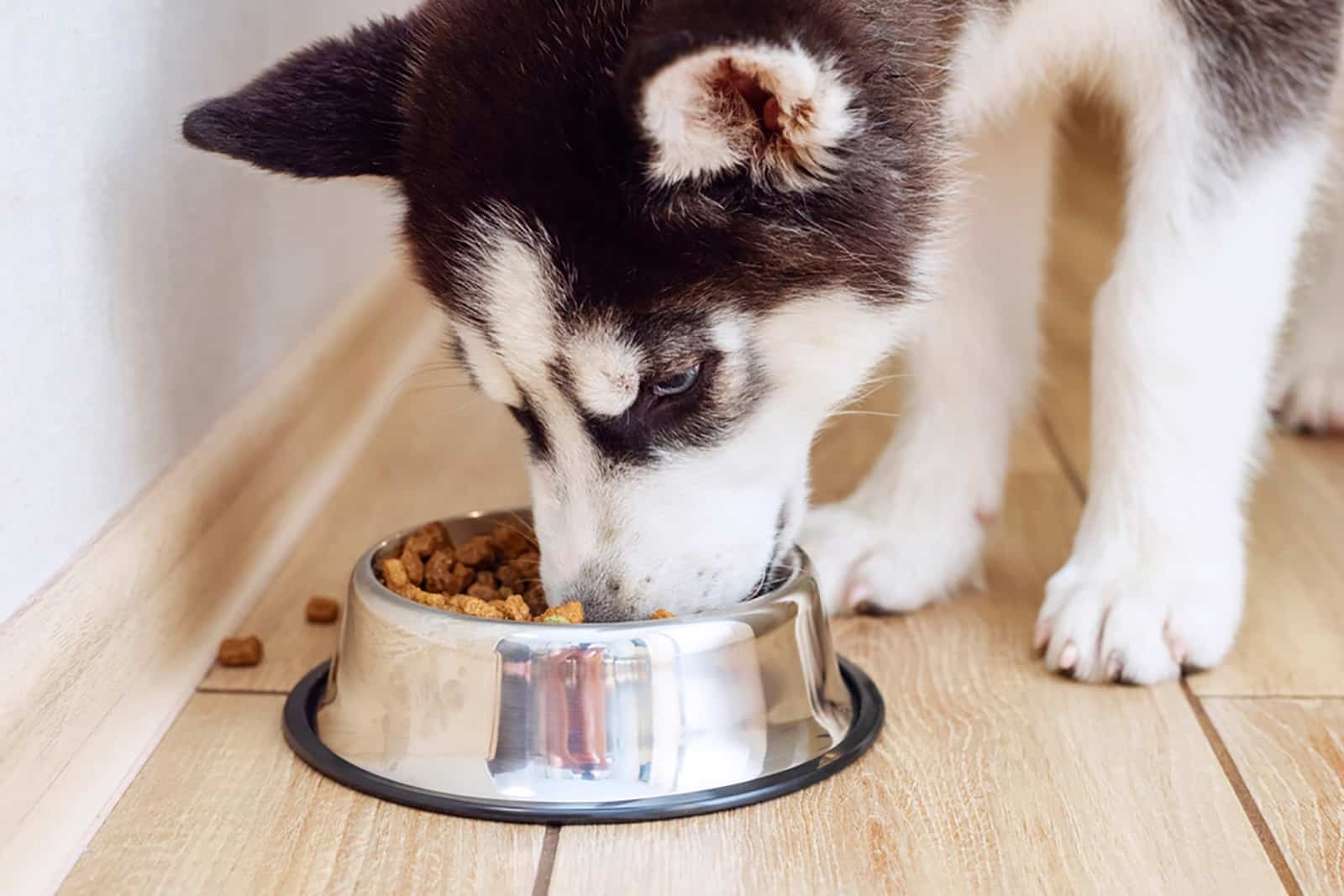Ohh, what do we have here? An irresistible blue-eyed beauty. A dog that is on his way to dethrone notoriously popular Labradors and German Shepherds.
Confess it… you have thought of getting one, too. They are just too beautiful not to be desired. I must admit that I have a huge urge to get one when I see them walking down the street.
But, before you or I do so, there are some things that we need to learn. First on the list is their eating habits.
So, let’s start with the Siberian Husky feeding chart.
If you live in the United Kingdom, and you are looking for one of these dogs, please check out best Husky breeders in The UK!
Siberian Husky Feeding Chart Explained
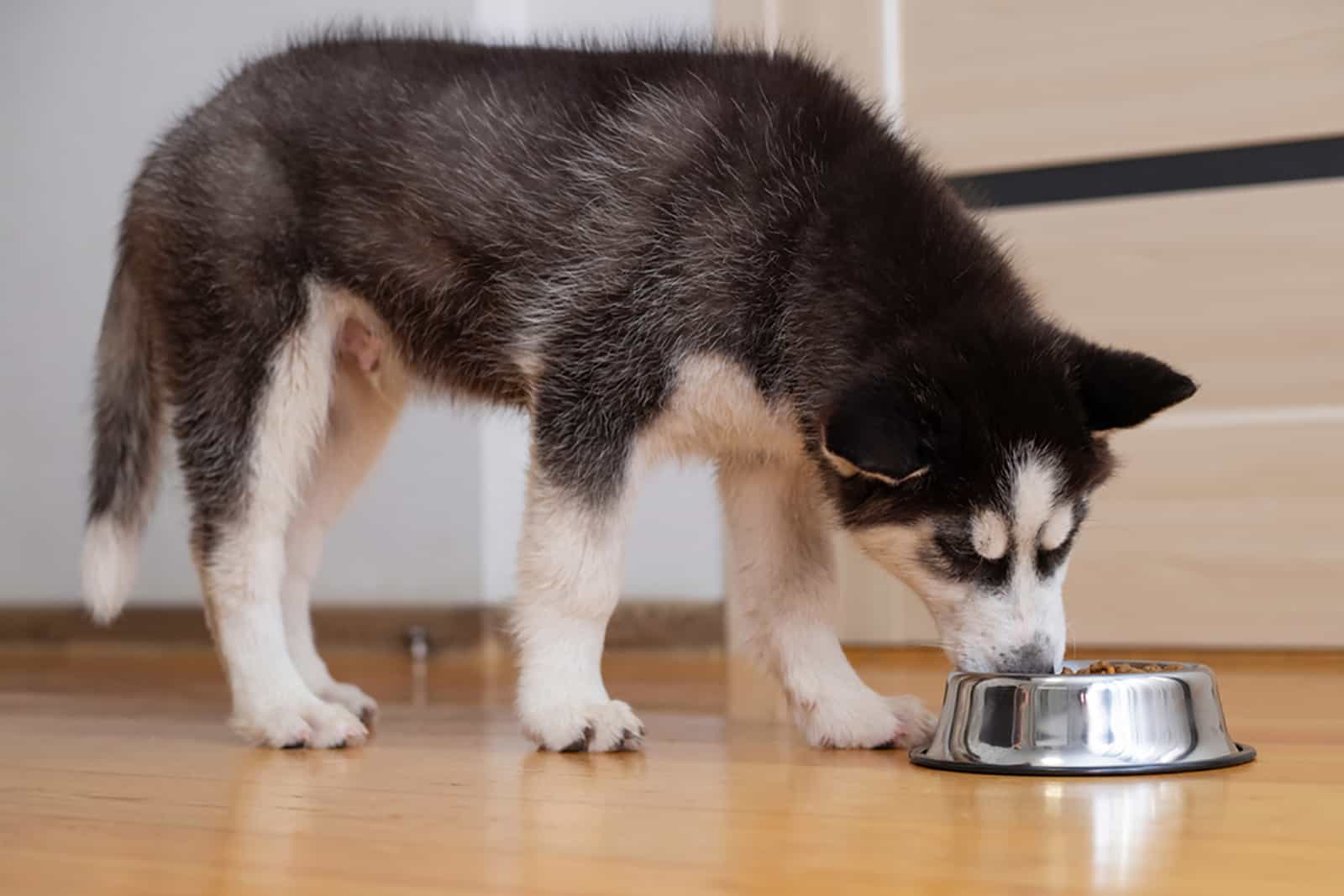
What every top Siberian Husky breeder knows is that it is of big importance to follow a quality Siberian Husky feeding chart.
This dog breed is getting more and more popular, and a big part of this is because of its enchanting looks – it is a gorgeous blue-eyed dog that you can find in equally beautiful Husky colors.
But, most people are not aware of how challenging this dog breed is. An adult Siberian Husky requires some serious skills to be handled properly.
His feeding process could be challenging also, but here is a Siberian Husky feeding chart which will ease that part.
Siberian Husky Puppy Feeding Chart
[table id=523 /]
Siberian Husky Feeding Chart By Weeks And Months
We will immediately hop to the sixth week of a Siberian Husky’s life. The first weeks are reserved for the close bonding of mother and her offspring over the process of feeding.
His mother is always beside him, nurturing, warming, and feeding him. But, then comes the time to slowly step into the world of adults.
One of the first steps could be transitioning to adult food. But beware… this process should also be slow.
Feeding From Six To 13 Weeks
Before your dog stops drinking his mother’s milk, you can start giving him solid food. Puppies usually stop breastfeeding somewhere between eight and 12 weeks.
You can start introducing him to puppy food two weeks earlier, but this process should start between six and 13 weeks… not later.
If you decide to introduce dry food, you should find ways to soften dog food.
You can also make puppy mush for your doggo, so he will be more eager to try it.
It is recommended to make a mush of 80% dry food and 20% wet food.
His meal should be dispersed in smaller portions, and served four times a day while he is young, plus breastfeeding. The quantity of food is presented in the Siberian Husky feeding chart.
Feeding From Three To Six Months
It may seem that your puppy is always hungry, but he is developing and changing, and this is also a time when you can bring in some changes for him.
You should start with changing his feeding schedule and cutting the number of meals throughout the day. Now, your puppy can eat three times a day instead of four.
Since they are transitioning to their adult shape, their body shape is changing in this period. It is time for them to lose their puppy fat and get that lean and compact look.
Feeding From Six To 12 Months
The development goes rapidly and everything changes quickly. So, it seems that just in the blink of an eye, your dog has become big.
Now, he is ready to reduce the number of meals from three to two a day. Of course, the quantity of food will remain appropriate… it is just the number of meals that are being cut down.
There is another thing you should take into account. Your dog should transition to adult food if he has been neutered.
He will be in pain after being neutered, but right after, you should start offering him food for adults because these dogs tend to put on some weight after the procedure.
If you have decided that you are not going to get him neutered, then keep the puppy food in the kibble for some time because he will need all the puppy nutrients.
Feeding From 12 Months And Up
Congratulations… you have a fully-grown adult Husky. If you don’t know how long it takes for a dog to gain weight that will be unhealthy for him, then be careful about the food amounts.
This is the beginning of the period where your dog eats only adult food. The difference between adult and puppy food is in the number and sort of nutritive stuff in it, and also the number of calories.
Grown-up food is much less caloric because grown dogs don’t grow anymore and they don’t need so much calorie fuel for developing processes. They need energy for everyday activities, and all of that is contained in adult food.
Siberian Husky Feeding Chart In Adulthood
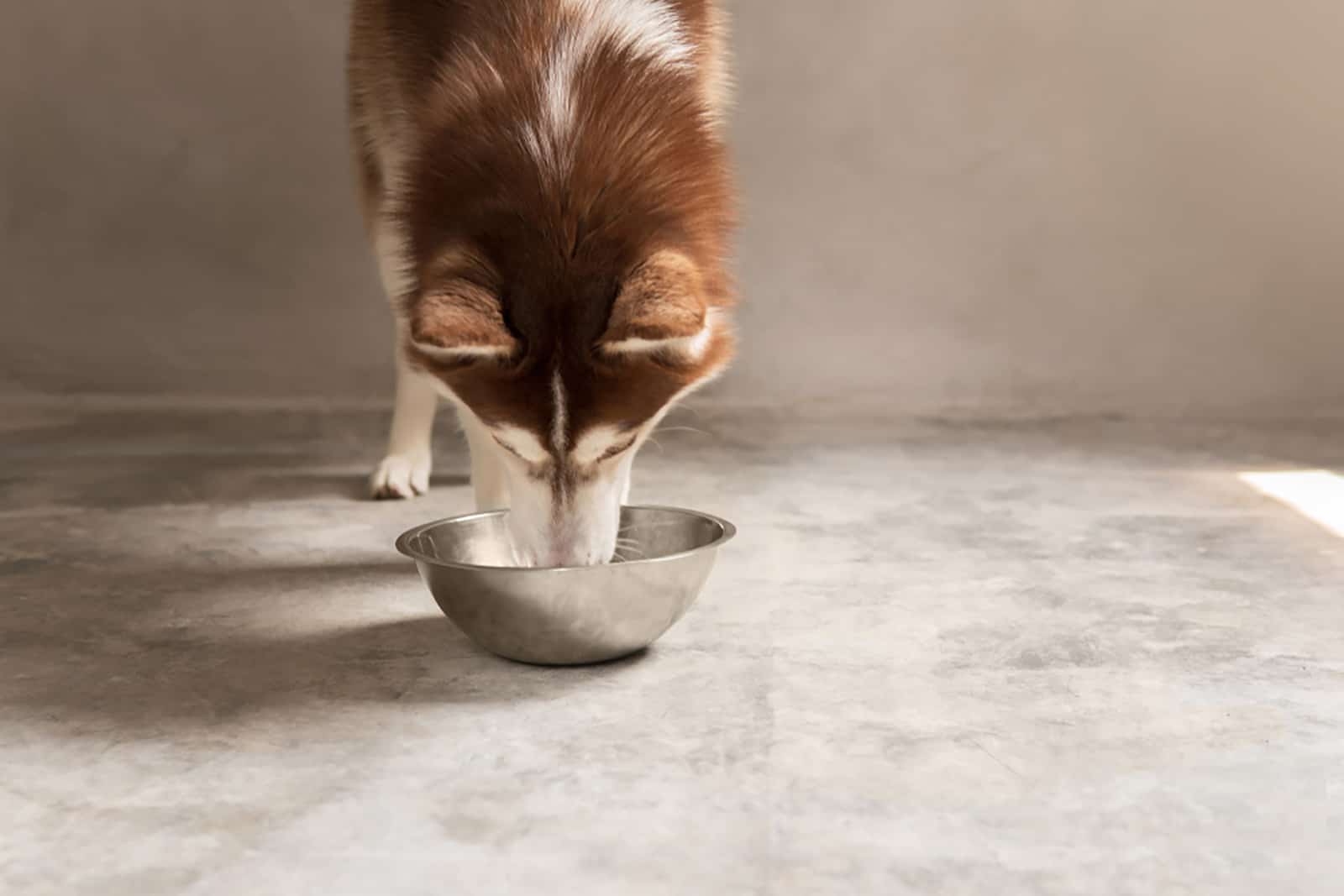
The calorie intake needs are much different during the first year of life compared to the rest of the Husky’s life.
While a very young dog needs a lot because he is growing, a grown dog needs food that will keep him energized for his daily tasks.
Feeding From One To Six Years
Huskies are dogs with a huge appetite, but if they are not active enough, they will gain weight.
Since they live mostly as family dogs, they are not as active as their breed used to be back in the days.
Nevertheless, they are still highly energized, and they need to let their energy out. But, they also need to put some energy in, so the owner is the one who has to estimate the right amount of food.
The Siberian Husky feeding chart is here to make it easier and with less stress.
And, the chart recommends two and a half to three and three quarters cups with food during the second and third year of his life.
From the fourth to the seventh year, the number of cups should rise to four cups in a day.
These measures shouldn’t be taken blindly. These are recommendations, but you are the one who knows your dog best and who needs to make the judgment as to what the optimal amount is.
There are other factors that may make an impact such as neutering, pregnancy, breastfeeding, and so on. Also, different Siberian Husky mixes can require different feeding approaches. It is all individual.
Feeding From Seven Years And Up
Siberian Huskies that are older than seven years are called senior dogs. This is a game changer because these pups are a bit less active than their younger colleagues.
This means less need for energy intake because it is less likely that it is going to be spent in daily physical activities. And, if they don’t spend their calories, those calories will turn into fat and you will have a dog that is overweight.
Old age brings wisdom, but it also brings slower metabolism, and often many health issues.
There is even a possibility that in one moment, you have to think of what to feed a sick dog with no appetite, while at another time, your dog would eat anything.
It is that their stomach becomes sensitive, they can’t work through many kinds of food as they could earlier, and their overall body condition is not excellent.
That is why you should be careful as to what you feed your old pup, and how much.
Some general guidelines are three cups of food daily.
If you are too anxious about what food you should give your dog, maybe the best choice is quality commercial food that is specialized for that age.
Remember to serve water along with the meal. It can help a lot in the process of digestion.
How Much Food Should A Siberian Husky Eat?
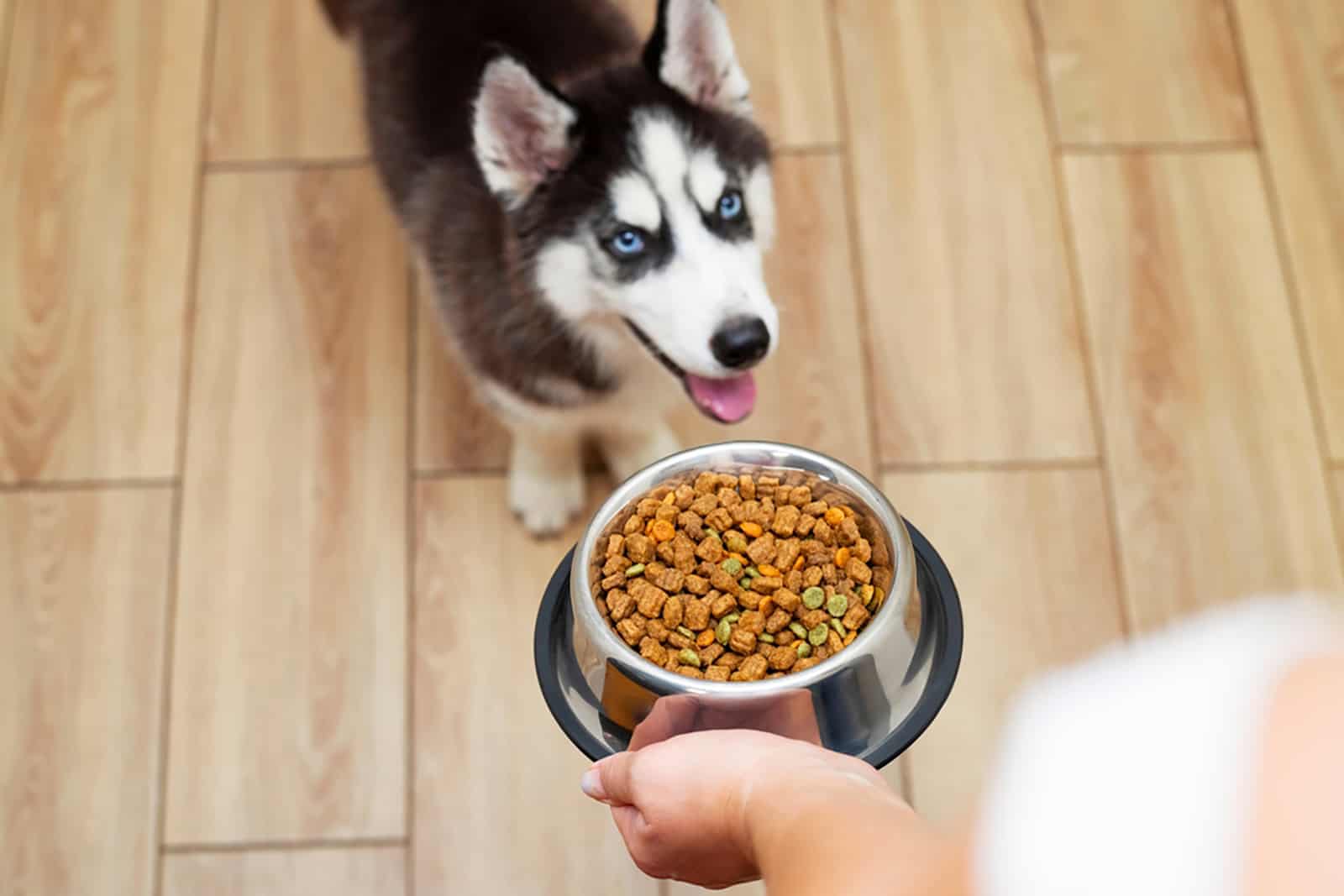
What you definitely shouldn’t do is freely feed your dog. Huskies sometimes can be picky eaters, but most of the time, they will eat pretty much anything until they are full. But still, it is better to create some feeding schedule.
That way, your dog will more easily get used to other house rules.
Experts say that you should follow the instructions on the package, but reduce the prescribed amount of food by 20% in most cases. That amount of food should satisfy the energy needs of your dog.
There are some differneces in sex and body condition.
Sex
There might be some differences between male and female Huskies when it comes to appetite requieries. As you may guess, female dogs need a little bit less food than male dogs.
Pregnancy
Unless your dog is pregnant, then she will probably have some increased cravings, especially if the pregnancy is already high.
Also, young mothers that are breastfeeding their offspring will also need more energy than usual.
Spayed/neutered
Dogs that have been spayed or neutered can show slightly less activity levels, especially right after the surgery. This often means fewer food cravings than usual.
How Many Calories Should A Husky Eat Per Day?
Husky owners should be aware that their dog needs a lot of energy to properly function during the day. This means some seriously high-quality ingredients in his kibble.
It is important to follow the right feeding guide so the immune system, digestive system, and all other important links of the dog’s health can work properly.
This means grain-free, filler-free, preservative-free, toxin-free, and all other by-product free food. Dogs need food that is a rich protein source – rich with fatty acids like omega-3 and carbohydrates so it can satisfy its daily calorie intake.
If your Husky’s food is right, there won’t be any need for additional supplements.
When we talk of a grown-up Husky, then the lower limit for calorie intake is 1100 kcal a day, and that is on the days that your Husky isn’t very active.
An active Husky in its full power will need more than 1800 kcals a day. Older dogs can survive a day with 1000 kcals.
Siberian Husky Feeding Chart; Calorie Intake
[table id=528 /]
How Many Pounds Does A Husky Weigh?
The weight of a Husky certainly depends on its stage of development. Husky puppies and adult Huskies can’t have the same weight.
When we look at the Husky breed’s average information defined by the AKC (American Kennel Club), we will get some fine numbers.
We will find out that the average Husky male weighs somewhere between 45 and 60 pounds, while a Husky female is slightly lighter, weighing between 35 and 50 pounds.
All this mass is usually gained by the end of the sixth month, although some of them gain more weight when they reach their second year of life.
The first year, especially the first half, is a time of fast growth, and you can expect your dog to be lean and athletic.
He shouldn’t be too bulky or too skinny because both of these conditions mean that the Husky’s diet is not ideal.
If you can feel his ribs, then he doesn’t have a balanced diet, and he might not be getting the needed nutrients. But, if he is too plump, then you as the dog owner and a person who is responsible might consider changing his feeding schedule.
By this, I primarily mean restricting his food intake at a reasonable measure. Both of these states can cause some health issues that you would want to avoid for your dog.
Why Is My Siberian Husky Always Hungry?
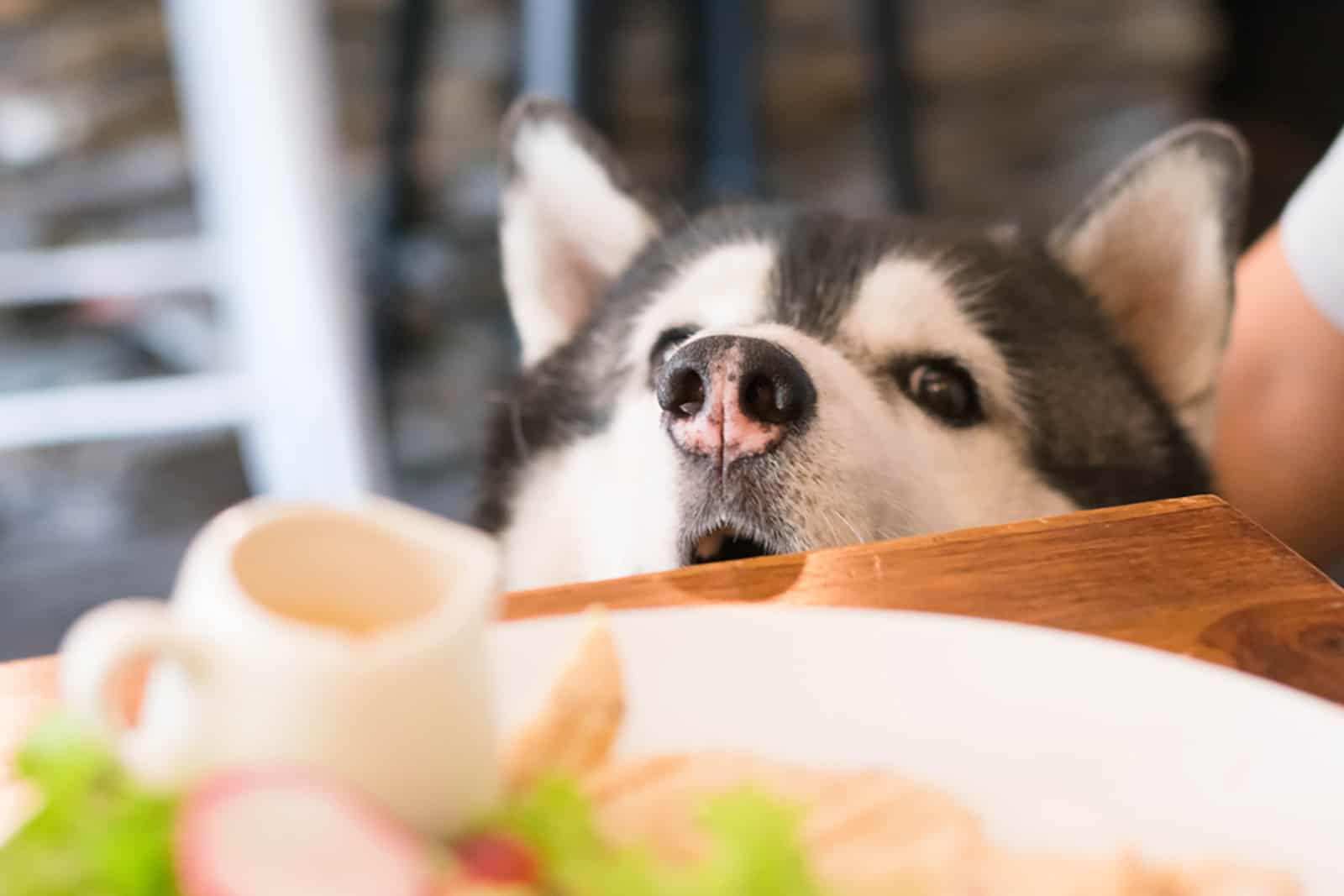
Now that we have learned about the Siberian Husky feeding chart, we can come to the conclusion that this dog has quite an appetite. But, why is that so? Why does he always appear to be hungry?
Well, try to imagine the picture. It is a cold Siberian winter, the night is slowly falling, and the temperature is way down below zero (hmm, maybe that is why there is a Wooly Husky with all his hair). And, a group of young Huskies in their full force is pulling a sledge full of groceries and medicine.
Okay, I know… I have just copied the scenario of the story of a Balto. But, hey… it is a true story, and the scenario of Balto was in Alaska, not Siberia. And, fyi… the roles of these dogs were pretty much the same.
Anyhow, let’s get back to the story.
These dogs that are running through the cold Siberian night are fighting against a snowy storm, a cold wind, and they are at the edge of their strength. But, one thought is pushing them further and further.
Oh… you must think that they think of their beloved master who will greet them with a smile.
Well, not quite true, but not quite false.
They are thinking about a delicious meal that is awaiting them, that their master has prepared for them.
The Matter Of Genetics
Huskies are one of the Russian dog breeds, and those breeds are known to be quite harsh just like the area they were raised in.
Huskies are also one of the large breeds, and they are well known as working dogs. We have mentioned earlier how they pull sledges in Siberia.
And, they are doing it all in very harsh weather and terrain, which requires (as you may guess) a lot of energy. Even Husky howling takes energy consumption. If you try to vocalize in the cold Siberian night, it would not be easy.
So, high energy consumption requires a big amount of food intake. And, these Huskies used any opportunity they had to eat food in order to have an energy reserve.
It was like a never-ending appetite. But, at the time, it was a matter of surviving.
Today, most Huskies are family dogs that spend their days far less active in comparison to their ancestors, but their eating habits have remained the same mostly because of their inherited genes.
Other Factors
It is not just genetics that can affect your dog’s appetite. There are also factors of growth, low nutritive value of food, worms, too much exercise, and heat.
Growth
The explanation to this one is actually very simple – your dog is in his developmental phase. He needs a lot of energy that he gets from food for all this growing and playing and exploring stuff.
Low nutritive value of food
Some food brands are not as high-quality as others. You should be careful when buying a commercial dog food because it sometimes lacks very essential nutrients, while on the other hand, it is full of bad stuff like fillers and toxins.
So, your dog might be constantly hungry because he isn’t getting enough energy from the food he has been eating.
Worms
If you haven’t taken your dog to get him dewormed recently, then worms might be causing the constant hunger.
It is an issue that can be easily solved, and it will rid you of a lot of dilemmas.
Too much exercise
Maybe you wonder how often you should take your dog for a walk? Or, how much running, playing, hiking, and overall exercise is enough in a day?
It is well known that Huskies need a lot of daily exercise – almost three hours a day, but it might happen that he has a calorie deficiency while he is spending more than he takes in.
And, that might be the reason why your dog is craving so much for more food.
Heat
Siberian Husky – the name says pretty much all about the weather this breed is used to. Huskies are a northern breed that is well equipped for freezing conditions.
But, you can also find many Huskies living in hot southern regions, and they can get overheated there. So, they lose their appetite in the warm months.
But, in the cold months, their appetite comes back, and they seem to eat non-stop.
What Is The Best Food For Siberian Huskies?
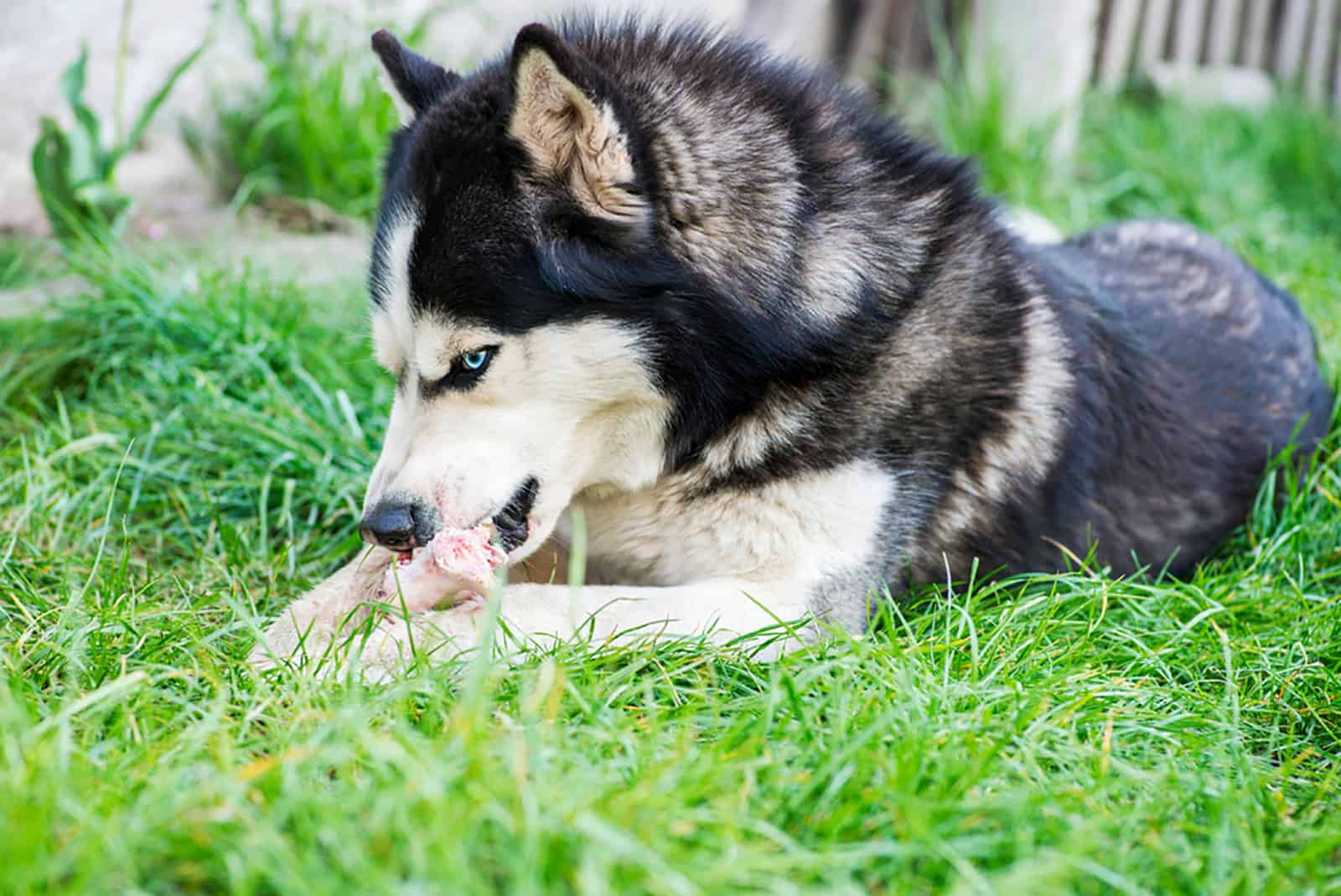
It is great that you have so many options when it comes to one of the most important parts of your dog’s life, and maybe the most fundamental. The right nutrition is the foundation to every other activity in a dog’s life.
But, there is another side of so many choices – it is actually hard to choose.
There are many places where you can purchase commercial food – a pet store, or online on Amazon or Chewy, for example. You should check out all options.
I know how stressful it can be to make the right choice for your beloved four-legged furry pal, but we are here to step in and help you make the right combination.
Yes, you can make a combination and create the perfect diet for your dog. Let’s get into it.
Dry Food
There are plenty of choices when it comes to commercial food. But, the most important choice is whether you will choose high- or low-quality food.
I bet you know which one you should aim for. High-quality food contains everything your puppy or a grown-up dog needs.
Dry food can have its own advantages. It is a more suitable choice if you don’t have enough time to spend on cleaning your dog’s teeth. Also, it may help with Siberian Husky teething.
Finely balanced food is the key to long-term life quality. That is why you should check the ingredients on the back of the package.
Also, make sure you choose the adult food for adult dogs, and puppy food for puppies.
Wet Food
Pretty much like dry food, there are plenty of choices when it comes to wet food. The method is the same – always choose quality.
Like dry food, wet food also has its qualities. 75% of its mass is made of water, so it is easier to digest.
That is why it is more suitable for older dogs that need to be reminded to drink water. This way, you will be more assured that they are hydrated.
This is also valid for dogs that are having some stomach troubles or that are ill and losing water excessively.
Raw Food
When switching to a raw diet, you should think about the benefits and dangers of raw meat.
It is a great option because you are avoiding possible toxins from processed food. On the other hand, if you are not careful enough, you can expose your dog to harmful bacteria from spoiled meat.
If you decide to transition to a raw diet immediately in puppyhood, make sure you investigate how much raw food you should feed your puppy.
You can introduce him to raw meat, fresh eggs, fresh fish, and some veggies like carrots.
Just make sure that everything is fresh and vet-checked for possible bacterial diseases like brucellosis.
Homemade Food
If you are still into avoiding processed food, but you want to be 100% sure you have also avoided bacteria, you can always turn to cooking.
It takes a bit more time, but you can deal with it with good preparation.
There are many recipes on the internet that can be easily prepared. Learn how to boil chicken for dogs or why you should prepare hamburgers and rice for dogs.
You can choose whole or ground meat, as well as high nutritive vegetables such as sweet potatoes, mangold, pumpkin, and carrots. You can also introduce him to cottage cheese and yogurt.
Also, if your dog is ill, cooking is the best option for feeding. There are, for example, many food recipes for kidney disease and other conditions.
What To Feed And What To Avoid?
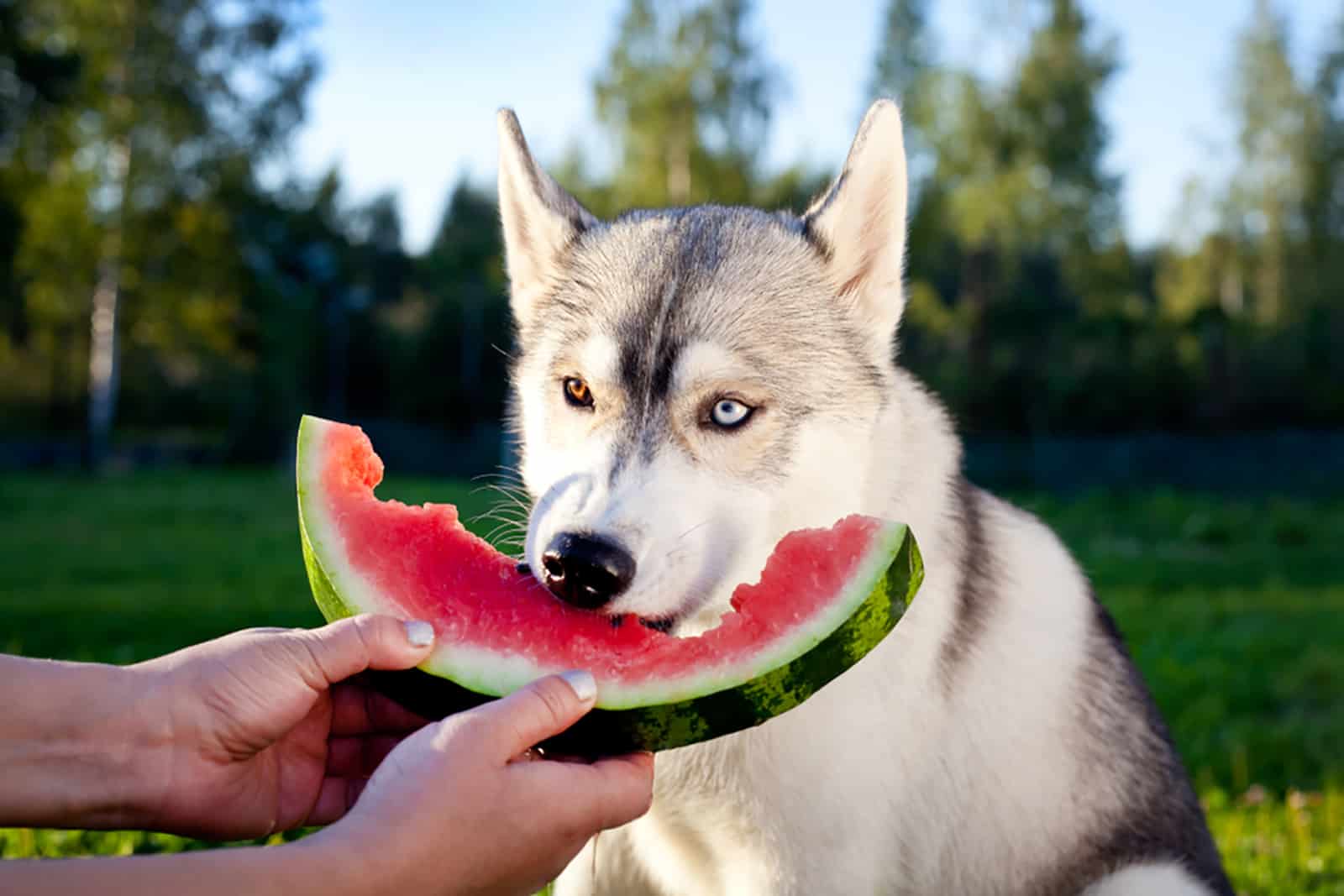
Versatile is always good. Your dog, just like you, should have a colorful diet filled with different ingredients like meat, veggies, and fruits.
Sometimes, we are tempted to feed our dog with the scraps of our meal, but two dangers are hiding behind that.
First, your dog can become obese by excessively eating your leftovers. The other is that your leftovers might contain some ingredients that are not quite suitable for him.
So, let’s learn what the do’s and don’ts are in the world of Siberian Husky feeding.
Green-Light Food
As we have stated earlier, a Husky’s diet should be composed of meat, vegetables, and fruits, and some other nutritive groceries like eggs or yogurt.
The important thing to remember is that these foods should be rich in calcium, phosphorus, selen, and zinc.
But, it should also contain a lot of protein (both veggie- and meat-based), along with fats, carbs, minerals, and vitamins. It should also contain omega 3 fatty acids and DHA.
These ingredients could be found in lamb, salmon, chicken, fish, duck, beef, cottage cheese, eggs, lentils, peas, sweet potatoes, carrots, apples, beans, blueberries, blackberries, and raspberries.
Red-Light Food
There are some ingredients that are not recommended as a nutritive meal, and besides that, they could be harmful.
You should definitely avoid giving your dog chocolate even if you feel like he should have something sweet after a meal.
Onion and garlic also aren’t the best options, as well as grapes and raisins.
Alcohol and caffeine are a big ‘no’.
Macadamia nuts are also dangerous for a dog, as well as some other nuts like some types of chestnuts.
Many processed foods are not recommended as a suitable ingredient for a dog’s diet; for example, sauerkraut, sausages, whipped cream and doritos.
Avocado is also one of the fruits that are not suitable for dogs.
There are also many hidden dangers behind yeast dough, milk, sugar, cooked bones, and corn.
All these ingredients might cause harm to the health of your pet, along with a visit to the vet.
When Is The Right Time To Transition From Puppy Food To Adult Dog Food?
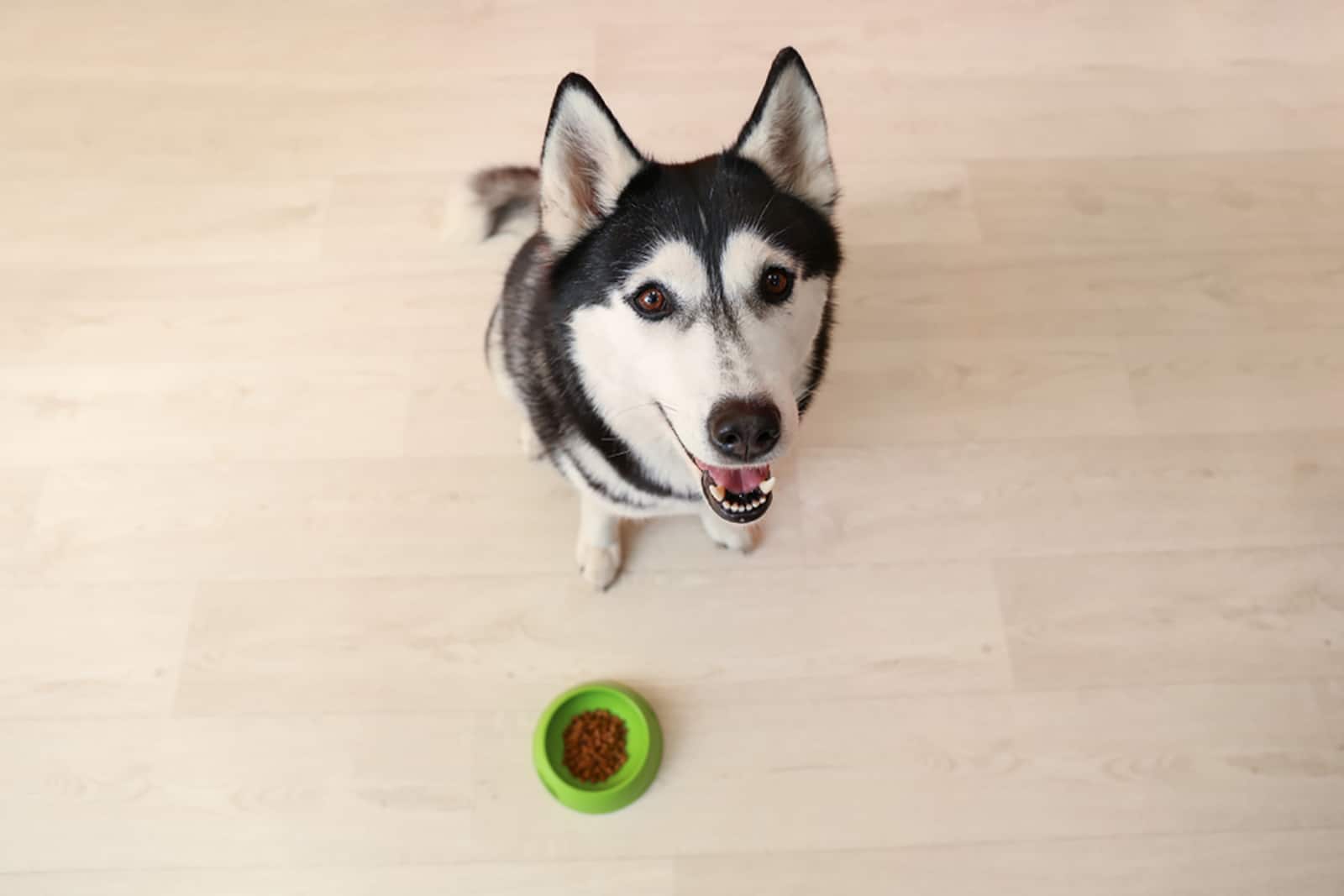
Some dogs have faster growth swings than others. For example, Siberian Huskies will reach their potential adult maturity faster than, let’s say Border Collies (you can check it out in this Border Collie growth chart).
That is why the process of transitioning to adult food is much faster for Huskies. You can start by introducing him to adult food at six months of age. That is only half a year, but in the dog world, it is not a short time span.
What is most important in any of the life stages is to choose the best dog food for Huskies… those foods that are full of nutrients that will help your dog to grow healthy and happy.
This is especially important at a young age because the first half of their first year is the time of their fastest growth.
That is the time when he needs some extra push in the shape of good food with high protein levels and rich calcium for the bones.
When the dog has finally reached an adult shape at six months, its growth becomes much slower. And, it is the time to watch how much you feed your dog so that he doesn’t become obese.
When you start with the process of transitioning from puppy to adult food, make sure you do it step by step, and not all of the sudden.
If you switch the food “overnight”, it may cause a shock to the sensitive stomach of your dog. And, we don’t want to know how to clean diarrhea out of carpet, or something worse.
Careful increasing of the amount of adult food will do the job.
To Wrap Up On The Siberian Husky Feeding Chart
Siberian Huskies are rising stars among dog breeds, and they are a sight you can see more and more these days.
But, before you decide to get yourself one of these demanding dogs, make sure you investigate a bit about them.
This means learning about the Siberian Husky feeding chart, growth chart, their behavior, their maintenance requirements, and other useful tips.
Good preparation is half of the job done, and I am sure that if you do this part of the process right, there won’t be many issues in the future.
Read More:
Shiba Inu Feeding Chart – What The Ideal Dog Diet Looks Like
Cocker Spaniel Feeding Chart: How Much And What Do Cockers Eat?
Doberman Feeding Chart – What The Perfect Dog Diet Looks Like
